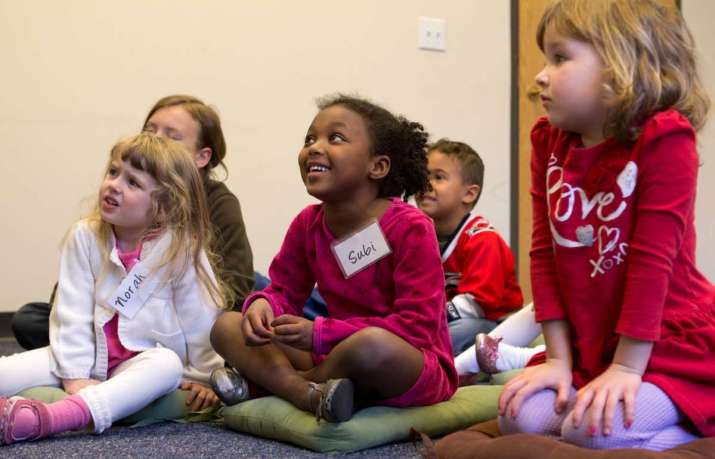
“The family is the first sangha. It’s a little mini-sangha,” says Sumi Loundon Kim.
Kim is the author of Sitting Together (Wisdom Publications 2017), a book that offers practical, lesson-based Buddhist activities for families. Perhaps books is more accurate; the set contains three volumes, plus an online companion where families can download songs and stories. With lessons for parents, activities for children, and strategies for incorporating meditation, compassion, and Buddhism into home life, Sitting Together is an extensive and innovative curriculum for Buddhist families.
Kim, a Buddhist chaplain at Yale University, says that parents often have no time to meditate, but the stressed-out, too-busy modern mom or dad need meditation more than ever.
“For parents to really become better Dharma parents, to become wonderful, spiritually grounded parents, they needed to heal, to work on that deeper psychological aspect to their parenting,” Kim explains. “What we manifest right now is the flower, but we need to go into the roots to really transform how we parent.”
Sitting Together takes a practical approach. Knowing the exhaustion and chaos that accompany raising children, Kim doesn’t suggest everyone sit together for an hour a day. Instead, she finds each family member where they are. She encourages parents to form a peer group that meets once a week, where they can talk about topics like anger and patience, practice meditation together, and do brief homework assignments, such as making a mindful shopping list. For kids, the weekly guided curriculum resembles a preschool classroom, with lots of art, singing, games, and reading, all centered around Buddhist themes.
Kim developed the curriculum when she founded Buddhist Families of Durham (now Mindful Families of Durham), a family-centered practice group in North Carolina. In 2010, about 20 families came together through an interest in secular mindfulness, and Kim, then the Buddhist chaplain at Duke University, tried to put together weekly lessons for the adults and kids. Looking for resources, “I left no stone unturned in the English-speaking world,” Kim laughs. She found some lineage-specific ideas, and a few eight-week mindfulness programs, which seemed too short for her needs. She wanted something broader and more accessible to beginners. Inspired by Planting Seeds, a child-focused book from Thich Nhat Hanh’s Zen lineage, she began to write and teach her own lessons for children. It was “incredibly labor-intensive,” she says, and the lessons eventually manifested as Sitting Together.
Although it could be used by established Dharma communities, the curriculum has a DIY feel to it. “It’s a resource for small local groups. In theory it could be done by a single family, but it’s really something that works best in small or larger groups, rather than parents alone,” Kim says.
The group orientation relates to one of Sitting Together’s foci: relationships. Kim’s lessons begin with sitting meditation and the breath, but they expand outward into ideas of community, interdependence, and respecting the environment. The focus on sangha is intentional.
“I really want to shift how we think about the Dharma, to think about it more relationally. The Dharma is enacted and manifested in our relationships, and that’s where the rubber hits the road. We can be super kind when we’re by ourselves with a cat, but you know, where we really find compassion or kindness or generosity is in relationships,” says Kim. Since the family unit forms our first relationships, it’s the place to begin teaching kids those Dharma lessons.
So how do you teach kids about loving-kindness? How about “melting monsters with metta spray”? Kim suggests having children draw their emotional monsters, then spray them down with water bottles while saying, “May you be happy.” The ink runs, the kids have fun, and concepts of kindness permeate the activity. It’s one of the many creative, fun crafts that introduce Buddhist ideas in ways that little bodies will enjoy.
Kim grew up in a Zen community in the United States and she still remembers the visceral, tangible aspects of Buddhism as a child: the smell of incense, the act of bowing. “For kids, being spiritual is in their bodies,” she says. “‘Smells and bells’ are super important. If you get them as a kid, it’s like those experience enter your system somatically, on a really deep level. When you become an adult, if that sense is touched into, it reconnects you.”
The children’s activities in Sitting Together are sensory-based and often active. There’s mandala-making with vegetables, tag games that encourage body awareness, and the adorable Teddy Bear Breathing Meditation. A workbook full of lotus connect-the-dots and Five Precepts coloring sheets accompanies the curriculum. Just because active little ones can’t always sit still on the cushion, Kim reasons, doesn’t mean they can’t interact with Buddhist ideas.
The parent-focused activities are more traditional: Dharma discussion and meditation. Because the two curricula are designed to run parallel, with parents and kids practicing separately, the family unit becomes the place where new practices flower in daily life. As Kim emphasizes, the family sangha integrates individual practices into loving, sometimes difficult relationships. “Ideally you want to have [the curriculum] be equally developed for both parents and children, and then integrate it into the family as a system,” she explains.
Laypeople and householders with children often think they have no time for meditation practice. While it can seem overwhelming to approach an entire multi-volume curriculum when you barely have time to shower, Kim says the root of the books is individual attention. That can be done with or without a curriculum, she says. Family life offers a natural introduction to many Buddhist concepts, one that Sitting Together harnesses and makes explicit. “With our children, there’s this amazing world of interbeing and interconnectedness,” Kim says. “I think parents have the opportunity to feel this and experience this . . . there’s a fertile ground for practice.”
See more
Mindful Families
Planting Seeds (Plum Village)













